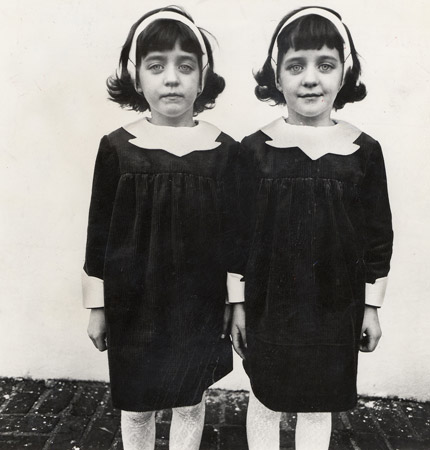Grotesque images don’t bother us unless they remind us of ourselves–then they’re appalling. Photographer Diane Arbus was the most famous cataloger of people who broke the mold: giants, dwarves, twins, transvestites, etc. She was accused of exploitation, but she was always really exploring the frailties of those viewing, not those on view. In the above classic 1966 photo, Arbus’ subjects are twin girls who are identical save expressions set in different directions.
Arbus committed suicide in July 1971. From her Village Voice obituary by A.D. Coleman: “Diane Arbus slashed her wrist and bled to death in her Westbeth apartment–sometime late Monday or early Tuesday, since her diary contained an entry dated Monday, July 25. Hers was the third suicide at Westbeth, the second by a photographer. Her body was discovered by her close friend Marvin Israel, on Wednesday, July 28. Funeral services were held at Campbell’s on Madison Avenue. She was 48 years old.
Diane Arbus studied with Lisette Model and earned her living as a commercial photographer, but her concern as an artist–I should say her concerns, as twinned as the children in one of her most famous images–were the freakishness of normalcy and the normalcy of freakishness. She called freaks ‘the quiet minorities,’ and defined her special field of interest in photography as a ‘sort of contemporary anthropology,’ much reminiscent of August Sander, with whose work her own had considerable affinity.
In a 1967 interview for Newsweek, she said about freaks, ‘There’s a quality of legend about them. They’ve passed their test in life. Most people go through life dreading they’ll have a traumatic experience. Freaks were born with their trauma. They’ve already passed it. They’re aristocrats.’
And, about herself, in a more recent statement: ‘Once I dreamed I was on a gorgeous ocean liner, all pale, gilded, cupid-encrusted, rococo as a wedding cake. There was smoke in the air, people were drinking and gambling. I knew the ship was on fire and we were sinking, slowly. They knew it too but they were very gay, dancing and singing and kissing, a little delirious. There was no hope. I was terribly elated. I could photograph anything I wanted to.'”

